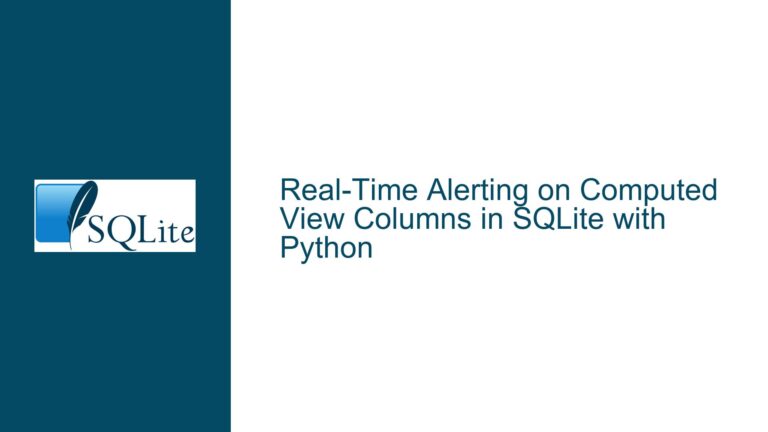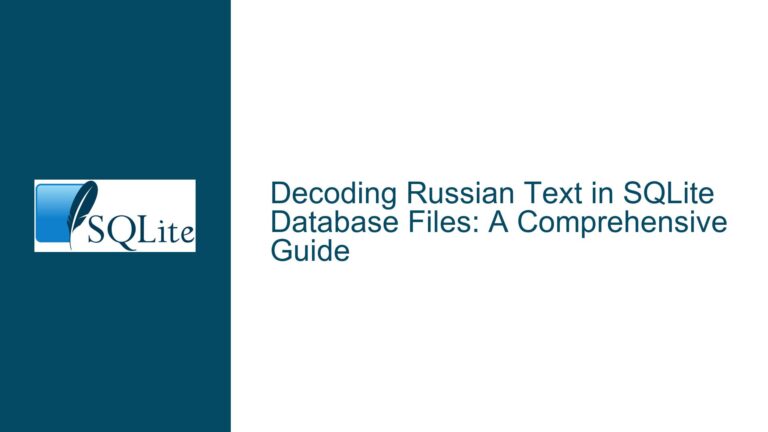Preventing Duplicate Entries in ORM-Based SQLite Insertions
Issue Overview: Uncontrolled Record Insertion in ORM-Managed SQLite
The core problem revolves around a C++ application using an Object-Relational Mapping (ORM) layer (likely ODB) to interact with an SQLite database. The initialiseDB function persists a new EntityType record with the value "Tank" into the database. However, this function repeatedly inserts the same row every time the program runs, leading to duplicate entries. The goal is to ensure the "Tank" record is inserted only once, when the table is empty or lacks this specific entry. The challenge lies in correctly invoking the ORM’s find method to check for existing records before performing an insertion.
This issue is exacerbated by the absence of direct SQLite API usage. The ORM abstracts database operations, requiring the developer to rely on its internal mechanisms for query execution, transaction management, and object persistence. Key points of confusion include:
- ORM-Specific Query Semantics: The
findmethod’s behavior is determined by the ORM’s design. It may require an entity’s primary key (ID) to locate records, making it unsuitable for checking existence based on non-ID fields (e.g., "Tank" in theEntityTypetable). - Transaction Scope: The current implementation wraps the insertion in a transaction but does not integrate the existence check into the same transaction. This could lead to race conditions if multiple instances of the program attempt to initialize the database simultaneously.
- Lack of Conditional Insertion Logic: The
initialiseDBfunction unconditionally persists the "Tank" entity without verifying whether it already exists. This results in redundant rows.
Possible Causes: ORM Misconfiguration and Query Logic Gaps
Cause 1: Incorrect Usage of the ORM’s find Method
The ORM’s find method is templated and appears to require an id_type parameter, suggesting it is designed to retrieve records by their primary key. If the "Tank" entity’s ID is auto-generated or not known in advance, using find with an ID is impractical. The developer might be attempting to check for the existence of "Tank" by its name, which the find method does not support directly. This mismatch between the query criteria (name) and the ORM’s retrieval mechanism (ID) leads to failed existence checks, causing the unconditional insertion to proceed.
Cause 2: Absence of Table-State Validation Logic
The initialiseDB function lacks a pre-insertion check to determine whether the table is empty or contains the "Tank" record. Without this validation, the persist operation executes regardless of the table’s state. This could stem from:
- Misunderstanding the ORM’s Query Capabilities: Assuming the
findmethod can perform existence checks without primary keys. - Incomplete Error Handling: Failing to handle cases where the
findmethod returnsnullptrorfalse, which should trigger the insertion logic.
Cause 3: Transaction Isolation and Race Conditions
The current transaction (t2) only encompasses the insertion operation. If the existence check (via find) is performed outside this transaction, another process could modify the table between the check and the insertion, leading to duplicates. The ORM’s transaction isolation level and locking behavior also play a role here. For example, if the isolation level is set to READ_UNCOMMITTED, the find method might not detect uncommitted inserts from other transactions.
Troubleshooting Steps, Solutions & Fixes
Step 1: Analyze the ORM’s Query Generation and Execution
Action: Capture the SQL statements generated by the ORM during find and persist operations. Most ORMs provide logging mechanisms to output generated SQL. For example, ODB enables logging via the --generate-schema option or runtime configuration.
Expected Outcome: Determine whether the find method generates a SELECT query targeting the primary key column (e.g., SELECT * FROM EntityType WHERE id = ?). If so, using find to check for "Tank" by name is impossible without additional configuration.
Example Workflow:
- Enable SQL logging in the ORM.
- Run the program and observe the SQL generated during the
findcall. - Verify if the query includes a
WHEREclause filtering byname = "Tank"or byid.
Resolution:
- If the ORM generates ID-based queries, modify the
EntityTypemapping to include a secondary index on thenamecolumn, enabling query-by-name. - Use custom query methods provided by the ORM (e.g.,
query_by_name) if available.
Step 2: Implement Conditional Insertion Using ORM Queries
Action: Refactor the initialiseDB function to include an existence check before persisting the "Tank" entity. Use the ORM’s query API to search for "Tank" by name.
Example Code (Hypothetical):
void initialiseDB(std::unique_ptr<odb::database>& db) {
try {
odb::transaction t2(db->begin());
// Custom query to find EntityType by name
typedef odb::query<EntityType> Query;
auto result = db->query<EntityType>(Query::name == "Tank");
if (result.empty()) {
auto tankType = std::make_shared<EntityType>("Tank");
db->persist(tankType.get());
}
t2.commit();
} catch (const odb::exception &e) {
std::cerr << e.what() << std::endl;
}
}
Key Adjustments:
- Replace the ID-based
findwith a custom query filtering byname. - Use
query<EntityType>to construct a criteria-based search. - Check if the result set is empty before inserting.
Caveats:
- Ensure the
EntityTypeclass has anamefield mapped to a database column. - Verify that the ORM supports criteria-based queries (e.g., via
odb::query).
Step 3: Enforce Transactional Integrity for Check-and-Insert Operations
Action: Ensure the existence check and insertion occur within the same transaction to prevent race conditions.
Example Modification:
void initialiseDB(std::unique_ptr<odb::database>& db) {
odb::transaction t2(db->begin());
try {
// Existence check and insertion within the same transaction
auto result = db->query<EntityType>(Query::name == "Tank");
if (result.empty()) {
auto tankType = std::make_shared<EntityType>("Tank");
db->persist(tankType.get());
}
t2.commit();
} catch (...) {
t2.rollback();
throw;
}
}
Rationale:
- Wrapping both operations in a single transaction ensures atomicity. Other processes will see either the pre-check state or the post-insert state, eliminating duplicates.
Step 4: Utilize ORM-Specific Features for Upsert Operations
Action: Explore whether the ORM supports "upsert" (insert-or-ignore) functionality. For example, SQLite’s INSERT OR IGNORE can be leveraged if the ORM allows raw SQL execution.
Example:
void initialiseDB(std::unique_ptr<odb::database>& db) {
try {
odb::transaction t2(db->begin());
db->execute("INSERT OR IGNORE INTO EntityType (name) VALUES ('Tank')");
t2.commit();
} catch (const odb::exception &e) {
std::cerr << e.what() << std::endl;
}
}
Considerations:
- Bypassing the ORM’s
persistmethod might violate encapsulation but guarantees atomicity. - Ensure the
EntityTypetable has aUNIQUEconstraint on thenamecolumn to makeINSERT OR IGNOREeffective.
Step 5: Validate ORM Mappings and Database Schema
Action: Inspect the EntityType class definition and the corresponding database schema. Confirm that the name column has a UNIQUE constraint to prevent duplicates at the database level.
Example Schema:
CREATE TABLE EntityType (
id INTEGER PRIMARY KEY AUTOINCREMENT,
name TEXT UNIQUE NOT NULL
);
Impact:
- The
UNIQUEconstraint ensures that duplicatenamevalues are rejected by SQLite, even if the ORM attempts to insert them. - Combine this with proper error handling to catch
odb::unique_violationexceptions.
Revised Code with Error Handling:
void initialiseDB(std::unique_ptr<odb::database>& db) {
try {
odb::transaction t2(db->begin());
auto tankType = std::make_shared<EntityType>("Tank");
db->persist(tankType.get());
t2.commit();
} catch (const odb::unique_violation &e) {
std::cerr << "Tank already exists: " << e.what() << std::endl;
t2.rollback();
} catch (const odb::exception &e) {
std::cerr << e.what() << std::endl;
t2.rollback();
}
}
Step 6: Consult ORM Documentation and Community Resources
Action: Review the ORM’s documentation for patterns related to conditional insertion and existence checks. For example, ODB provides find-by-criteria examples in its manual.
Key Search Terms:
- "ODB query by field"
- "ODB check if record exists"
- "ODB upsert example"
Example Documentation Snippet (ODB Manual):
"To query objects based on data member values, use the
odb::queryclass. For example, to find all employees with the first name ‘John’:typedef odb::query<Employee> Query; auto result = db.query<Employee>(Query::first == "John"); ```"
Outcome:
- Directly using the ORM’s query API avoids raw SQL and maintains abstraction.
Step 7: Test with Controlled Database States
Action: Simulate different database states (empty table, "Tank" exists, multiple entries) to validate the insertion logic.
Test Cases:
- Empty Table: The program should insert "Tank".
- "Tank" Exists: The program should skip insertion.
- Corrupted Data: The program should handle exceptions (e.g.,
unique_violation).
Automated Testing:
TEST_F(InitialiseDBTest, InsertsTankWhenTableEmpty) {
// Ensure table is empty
db->execute("DELETE FROM EntityType");
initialiseDB(db);
auto count = db->query_value<odb::result<EntityType>>();
ASSERT_EQ(count, 1);
}
TEST_F(InitialiseDBTest, SkipsInsertionWhenTankExists) {
// Pre-insert "Tank"
db->execute("INSERT INTO EntityType (name) VALUES ('Tank')");
initialiseDB(db);
auto count = db->query_value<odb::result<EntityType>>();
ASSERT_EQ(count, 1);
}
Step 8: Optimize Performance with Caching
Action: Cache the existence check result to avoid redundant database queries in subsequent initializations.
Example:
std::atomic<bool> tankInitialized{false};
void initialiseDB(std::unique_ptr<odb::database>& db) {
if (tankInitialized) return;
try {
odb::transaction t2(db->begin());
auto result = db->query<EntityType>(Query::name == "Tank");
if (result.empty()) {
auto tankType = std::make_shared<EntityType>("Tank");
db->persist(tankType.get());
}
t2.commit();
tankInitialized = true;
} catch (const odb::exception &e) {
// Handle exception
}
}
Caveats:
- Ensure thread safety if the function is called concurrently.
- Reset the cache if the database is modified externally.
Final Recommendations
- Prefer Database-Level Constraints: Use
UNIQUEconstraints to enforce data integrity. - Leverage ORM Query APIs: Avoid raw SQL unless necessary for performance or functionality.
- Atomic Transactions: Combine existence checks and insertions within a single transaction.
- Comprehensive Testing: Validate all edge cases, including concurrency scenarios.
By systematically addressing ORM-specific query mechanisms, transactional boundaries, and database schema design, developers can eliminate duplicate insertions while maintaining clean, maintainable code.






